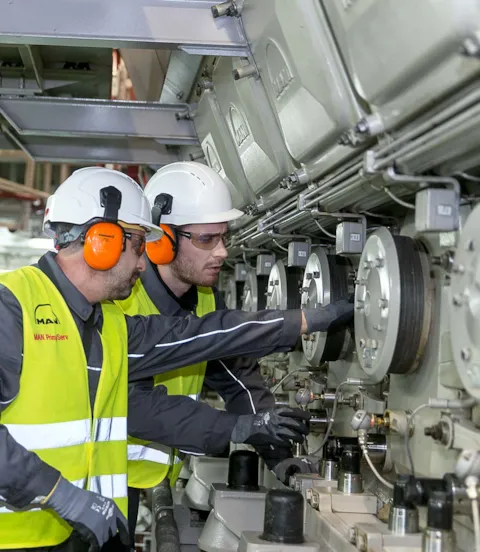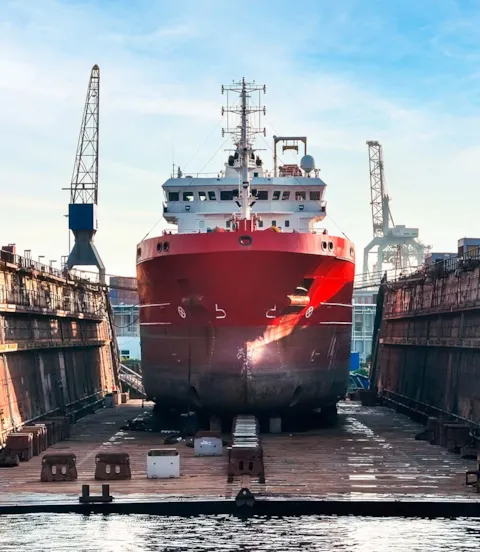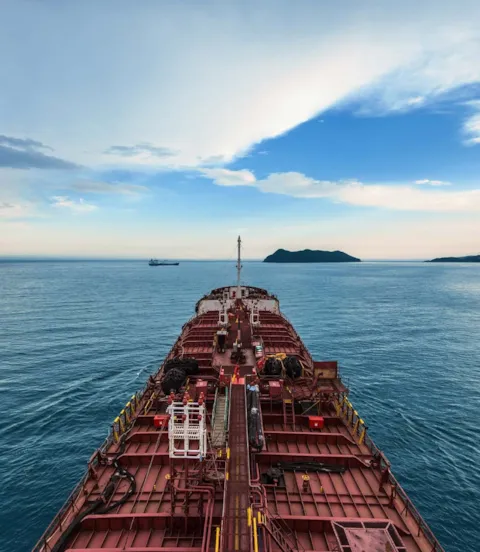Challenging road ahead for retrofitting to dual-fuel engines
The maritime industry’s decarbonization goals are multi-pronged and complex. A collaboration between DNV and engine designer MAN Energy Solutions examines how retrofitting the existing maritime fleet to dual-fuel engines capable of running on sustainable fuels can contribute to these goals.
In order for the shipping industry to achieve decarbonization that is sufficiently in line with the Paris Agreement’s goal of limiting global warming to 1.5 degrees Celsius, a full life-cycle approach – also known as a ‘well-to-wake emissions’ perspective – needs to be adopted. This forces the maritime industry to assess the emissions of shipping in a comprehensive way and moves shipowners away from the ‘tank-to-wake’ approach, where emissions reporting can be pushed upstream to the production of the fuel. At IMO’s MEPC 80 this approach will be further discussed.

‘Well-to-wake emissions’ perspective raises standards for existing fleet
While a number of innovations are being applied to the 1,500–2,000 two-stroke and 750 four-stroke new vessels that are launched per year, the greatest challenge to achieving maritime GHG reductions is for the existing merchant fleet, which consists of approximately 55,000 ships with two-stroke engines and 30,000 ships with four-stroke engines.
Retrofitting these existing ships to be able to run on alternative fuels like ammonia and methanol is one of the options available to the maritime industry to achieve desired reductions in emissions. However, the path ahead for retrofitting is uncertain.
“Apart from efficiency improvements and the use of biofuels, retrofitting is another option for the existing fleet to achieving decarbonization targets,” says DNV’s Business Development Manager Christos Chryssakis. “However, there is no requirement for retrofitting so the future timeline for achieving this is not clear.”

Biofuels not scalable for maritime industry
Currently, the most straightforward way of reducing emissions on the existing fleet is by running single-fuel engines on sustainable biofuels. Several biofuels, such as FAME and HVO, have ‘drop-in’ properties which means that they can be blended with existing fossil fuels. This is an attractive option to shipowners as it provides them with a flexible way of achieving decarbonization without having to make large capital investments.
However, a number of key challenges remain with biofuels. Although 2022 was a record-breaking year for the consumption of biofuels, this still accounted for just 0.1% of the maritime energy mix.
“Demand for biofuels is high from other industries, and supply is limited,” says Chryssakis. “This means that the maritime industry may struggle to acquire as much biofuel as it needs and that prices will be high. Therefore, it currently seems quite unlikely that biofuels will be a magic bullet for decarbonizing the entire existing maritime fleet.”

Retrofitting fleet provides long-term solution
With biofuels currently unscalable, converting large ships to dual-fuel engines is increasingly seen as one of the ways that the maritime industry could achieve its decarbonization targets. Retrofitting a single-fuel engine to dual-fuel enables a ship engine to run on a second sustainable fuel, as long as this is accompanied by a pilot injection of conventional fuel. While this conventional fuel will primarily be a traditional fossil fuel, sustainable biofuels or synthetic fuels can also be used.
Dual-fuel conversions have already been applied to converting the engines of energy carriers to the fuel being carried, most frequently to LNG and LPG. This has generally resulted in around a 15–20% reduction in exhaust emissions, highlighting the key role that both of these fuels occupy as transition fuels. However, in order to achieve decarbonization targets, dual-fuel conversions need to be made for fuels which can be produced to emit close to zero ‘well-to-wake emissions’, such as green ammonia, green methanol and e-fuels.

Larger ships most suitable for retrofitting
According to assessments by DNV and MAN ES, key retrofitting requirements for ships with two-stroke engines are electronically controlled engines, a bore size of at least 50 centimetres and a sea trial conducted after 1 January 2015. The cost of retrofitting, including the fuel storage and fuel supply system, ranges between USD 5 million and USD 15 million depending on the type of fuel and, as a rule of thumb, this should not exceed 25% of the newbuild cost of a ship to be economically viable.
A ship should typically have a minimum newbuild cost of around USD 50 million to be suitable for retrofitting. Ships fitting these criteria include tankers above 50,000 DWT, bulkers above 160,000 DWT and containers above 7,000 TEU, among others. However, in some cases, such as for ships retrofitting to methanol, this cost can be lower. For four-stroke engines, ships with large bore sizes that conducted a sea trial 8–15 years ago appear to be the best fit for dual-fuel retrofitting.
“Less than 10% of the existing global merchant fleet are regarded as theoretic candidates for retrofitting,” says Chryssakis. “We don’t see this happening today due to costs and uncertainties but think that this could be achieved over the next five to ten years, particularly after 2030 when regulations really start biting. However, it is difficult to predict how many of these will actually materialize.”

IMO regulations hindering shipowners from dual-fuel retrofitting
Although several states are pushing the IMO to be even more ambitious and aim for zero emissions by 2050, some of the organization’s regulations are standing in the way of a swift, large-scale dual-fuel retrofitting of the global fleet. Of most concern to advocates of retrofitting, the IMO currently demands that a parent engine test of exactly the same electronically controlled engine type is required for a dual-fuel conversion to be NOx compliant. However, relatively new engine technologies such as methanol and ammonia are not available for all bore sizes, which means that a parent test engine is often unavailable for some desired retrofits to dual-fuel engines.
In addition, certain older engine models, such as those running on heavy fuel oil (HFO), are not made for newbuilds anymore. This means that a newbuild parent engine is not available for testing in cases where a shipowner wishes to convert a HFO engine to dual fuel, thus making retrofitting extremely difficult under current IMO rules. Unless this regulation is amended, or new guidelines are developed, the pace of retrofitting will be significantly hindered.

Retrofitting engines also faces practical challenges
A number of other hurdles lie on the road to large-scale retrofitting. The implementation of dual-fuel conversions is expected to be carried out by a limited number of shipyards, due to varying commercial priorities. This may lead to capacity issues if there is high demand for conversions. Furthermore, the complexity of these kinds of projects and current uncertainty around best practices leaves shipowners and yards open to potentially large cost overruns. The higher costs of alternative fuels will also increase the economic worries of shipowners.
“The cost of fuels like ammonia and methanol presents an issue to shipowners wishing to reduce GHG emissions while also maintaining a profit,” says Chryssakis. “The price of these kinds of fuels is currently much higher than conventional marine fuels and shipowners will need to ensure that their charterers will be willing to cover the increased cost of fuels before committing large amounts of CAPEX to retrofitting projects.”

Carbon trading schemes will level out price differences
The high cost of alternative fuels compared to traditional options is already being addressed by the expected introduction of an emissions trading scheme (ETS) by the EU in 2024, with the IMO also set to introduce similar kinds of carbon pricing schemes further down the line. If implemented properly, these should help to level out the cost differences between new and conventional fuels, thus making dual-fuel conversions more financially attractive in the longer term.
Shipowners also need to be assured that scalable infrastructure will be developed for the fuels which they are retrofitting their engines to in ports and bunkering facilities. While this is no easy task, it is a crucial component which will require large-scale investment from ports, private energy suppliers and governments. Regulations, such as FuelEU Maritime, which encourage the use of low-carbon fuels, can help to encourage higher levels of investment and the IMO could implement similar standards in the future.

Commitment of all stakeholders required
Successfully overcoming all of these and not encountered, upcoming issues will require time and collaboration between a range of stakeholders.
“Shipyard capacities need to be built up and capabilities developed so that retrofitting can be done in a practical and cost-efficient way,” says Chryssakis. “Engine manufacturers need time and money to develop the most optimal dual-fuel solutions. Classification societies need as much information as possible to develop suitable frameworks for dual-fuel conversions so that ships continue to operate to the highest safety standards.”
All of this will require a solid legal framework and support from governments, the IMO and other regulatory bodies. Crucially, the maritime industry will also need the support from financial institutions so that the required amount of capital is made available to take on this monumental task. A number of green funding schemes, such as the Poseidon Principles, are already in place which should encourage investment in dual-fuel retrofitting projects.
Dual-fuel conversion is a complicated and challenging task. However, most stakeholders now agree that successfully achieving this goal is crucial if the maritime industry is serious about achieving its decarbonization goals.
- MAN Energy Solutions/www.juergennobel.de
- Getty Images/iStockphoto
- Shutterstock / vlaru
- vladsv - stock.adobe.com
- Shutterstock / Kardasov Films